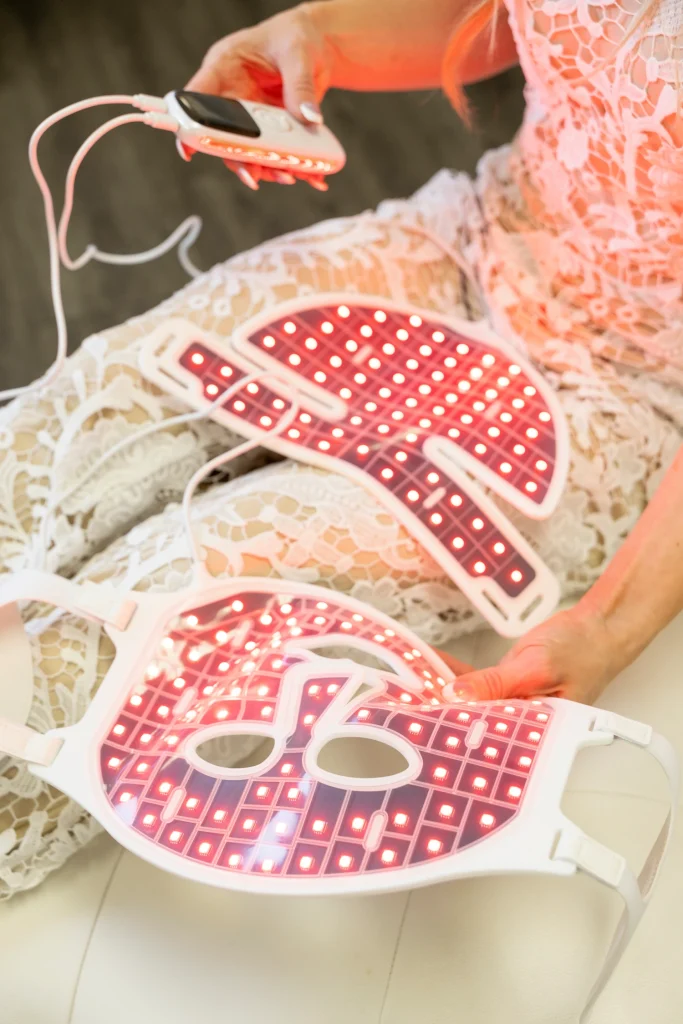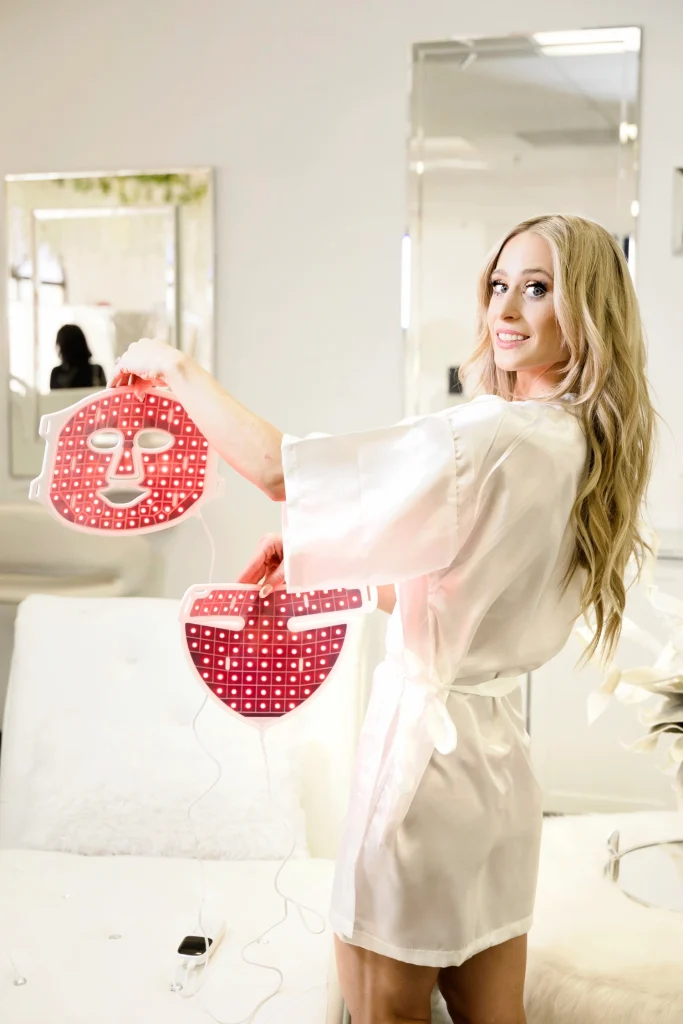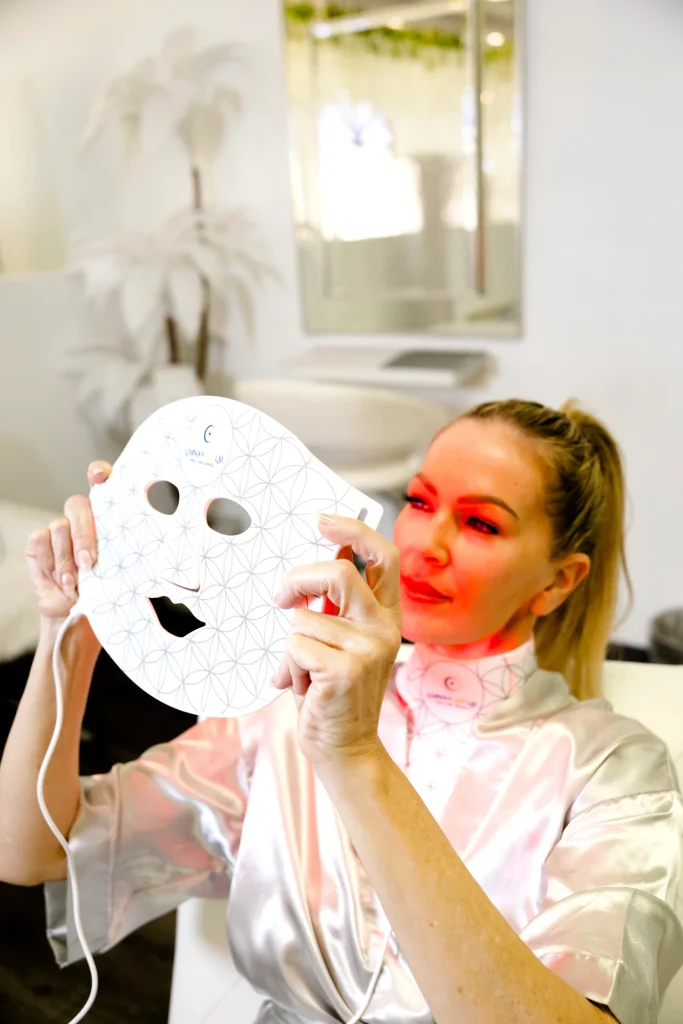Red light therapy has become one of the most talked-about treatments in skincare. You see it in spas, dermatologist offices, and now in at-home devices like the ILUMILUX mask. With all the buzz, one question still comes up often — is red light therapy safe for everyone? The truth is, red light therapy is very different from UV light. It does not harm the skin in any way.
Read on to learn how it interacts with different skin tones, what to watch for with sensitivities, and how to keep every session safe and effective.
How Red Light Interacts with Different Skin Tones
A lot of people hesitate to try red light therapy because they worry it might darken their skin or cause uneven spots. That’s an understandable concern — especially since many treatments that use light or heat can trigger pigment changes.
But red light therapy is non-UV, so it doesn’t tan or burn the skin. Instead, it supports the skin’s natural energy process at a cellular level. When red light reaches your skin, it targets the mitochondria — the “power source” inside your cells. That helps the skin produce more ATP, or cell energy.
More ATP means better repair, stronger structure, and smoother texture. None of this involves melanin production, so your tone stays consistent. In fact, many people notice their complexion looks more even after consistent use of a red light therapy mask.
Clinical studies confirm that red light therapy safety is consistent across various skin tones. The difference lies only in how the skin reflects light, not in how it reacts to it. The ILUMILUX mask spreads its light evenly across the entire face, so every area receives the same exposure and non-irritating coverage.
Is Red Light Therapy Safe for Darker Skin?
Yes — totally safe. Red light therapy for dark skin doesn’t interfere with melanin or trigger hyperpigmentation.
It works beneath the surface, not on pigment, so it won’t lighten or darken your skin. Instead, it helps calm inflammation, boost repair, and support a smooth, even tone.
Unlike some lasers that can cause burns or discoloration in darker tones, red light therapy keeps things gentle. It doesn’t rely on heat or pigment — it simply energizes your skin cells to help them function better. That’s why it’s a great option for every complexion.
If you have melasma, acne marks, or sensitivity, it can still fit into your routine.
Red light therapy can also be helpful for common issues in deeper tones, like:
- Post-acne dark spots – speeds up the skin’s renewal cycle so marks fade faster;
- Dryness or dullness – supports circulation to keep skin vibrant;
- Uneven tone – evens out redness or patchy areas over time;
- Inflammation – helps calm sensitivity without any sting or irritation.
If you recently had a laser treatment or struggle with photosensitivity, check with your dermatologist before starting. But in most cases, an FDA-cleared LED mask like ILUMILUX ensures safe red light therapy use across all complexions.
Skin Conditions and Sensitivities
Many people turn to red light therapy to help calm breakouts, redness, or irritation. It’s one of the few treatments that suits both acne-prone and red light therapy sensitive skin without harsh side effects.
Red light targets inflammation deep under the surface. That’s why it helps conditions like rosacea, eczema, and post-procedure redness. It supports the skin’s healing process instead of forcing it.
Each light mode serves a purpose: red light encourages repair and collagen support, while amber light eases redness and soothes irritation. With regular use, the skin appears calmer, more even, and less reactive. It aligns with findings on anti-inflammatory benefits in Photobiomodulation, Photomedicine, and Laser Surgery.
You should still skip sessions if your skin has open wounds, active infections, or fresh chemical peels. In those cases, wait for full recovery before resuming your routine. When used correctly, the LED red light face mask safety shows no long-term risks. It’s one of the safest non-invasive options for skin health available today.
Can red light therapy worsen rosacea or cause irritation?
No — and that’s one of the biggest myths about it. Red light therapy doesn’t trigger rosacea flare-ups. It usually helps calm them down. The light reaches deep into the skin to ease inflammation, soothe redness, and support healthy circulation. Instead of making the skin angry, it brings it back to balance. Most people with rosacea deal with flare-ups caused by heat, stress, spicy food, or certain skincare products.
The great thing about a mask like ILUMILUX is that it doesn’t produce the kind of heat that causes that reaction. It stays cool and gentle while the light does its job. The wavelengths used are the same ones dermatologists rely on to reduce inflammation and strengthen weak capillaries under the skin.
After a few sessions with red light therapy masks, many users start to notice less flushing across the cheeks and nose. The skin tone looks more even, and the constant redness softens into a calmer, more natural tone. It’s not an overnight fix, but it’s steady progress — the kind that lasts.
Here’s what you can usually expect if you choose to take red light therapy for acne or rosacea:
- Week 1–2 – you’ll notice less tightness after cleansing and fewer stinging sensations from skincare products. Redness may still come and go, but the flare-ups won’t feel as harsh.
- Week 3–5 – the overall redness begins to fade. Your skin feels softer and looks less inflamed. Pores appear smaller because the surface stays calmer.
- Week 6–8 – the texture starts to even out. Small broken capillaries become less visible. The skin feels stronger and more stable — not as reactive to temperature or stress.
By this stage, most people describe their skin as “finally calm.” And that’s the key. Red light therapy doesn’t just quiet surface redness — it helps the skin build resilience from within. If you’ve ever dealt with rosacea, you know it’s unpredictable. Some days, your skin looks fine.
Other days, one glass of wine or a hot shower can set it off. Red light therapy masks help minimize that unpredictability. It strengthens the skin barrier and restores normal function to overactive blood vessels.
Safety Standards and Best Practices
Red light therapy sounds high-tech, but it’s actually pretty simple. There’s no need for guesswork or complicated setups. You just want to make sure you’re using the right kind of device—and using it the right way.
FDA clearance, as verified through the U.S. FDA Device Database, is what separates a trusted device from a random light mask online. It means the product passed strict checks for safety, performance, and accuracy. ILUMILUX meets those standards, so you can use it at home with confidence. The mask provides gentle, even light. You don’t have to worry about any discomfort or irritation.
If your eyes are on the sensitive side, you’ve got options. Each ILUMILUX mask comes with a pair of light-blocking eye shields.
Toss them on before each session—they cut down on any glare or brightness but still let the therapy do its thing. You won’t have to squint or sit there wondering if you should’ve kept your eyes closed.
Is red light therapy completely safe for daily use?
Yes, it’s safe. But “safe” doesn’t always mean “every day.” The light itself won’t burn, sting, or damage your skin, but your skin still needs a little downtime. Think of it like taking vitamins: more isn’t better, it’s just extra that your body doesn’t use.
You’re likely to get the best results if you go for three to five sessions a week. That way, you can get the most benefits without pushing the skin too hard.
Your cells respond to the light by producing energy and boosting repair, but they also need time to finish that process. When you stack sessions too close together, you don’t give your skin enough space to recharge.
You won’t hurt yourself if you use it daily, but after a while, you might notice your skin looks a bit tired or less fresh. That’s your cue to take a short break. A day off between sessions will bring the glow back stronger.
If you’re new to red light therapy, ease into it. Start with shorter sessions — ten minutes or so — a few times a week. Once you see how your skin reacts, you can adjust your routine.
ILUMILUX makes it simple to stay on track. The built-in timer shuts off automatically, so you never have to guess when to stop. Just clean your skin, relax for a few minutes, and let the LED red light face mask handle the rest.
Here’s a quick guide to help you keep things simple:
- Start slow. Two or three times a week at first. See how your skin reacts.
- Build a rhythm. Move up to four or five times weekly if your skin feels fine.
- Keep sessions short. Ten to twenty minutes per use is plenty.
- Listen to your skin. If it feels dry or tight, take a day off.
- Stay consistent. Small, steady steps lead to better results than a daily marathon.
The point of red light therapy isn’t speed — it’s progress. The science behind ILUMILUX shows that even moderate use supports natural repair better than constant exposure. When you follow that balance, your skin gets the full benefit of the light — not just for a week, but for the long run.
Conclusion – Safe Light, Stronger Skin
Thanks to red light therapy safety, your skin will always look good. It’s non-UV, non-invasive, and safe for all skin types. There’s no burning, stinging, or downtime. It’s actually the opposite – calm, steady support for the skin’s natural repair process.
Over time, you’ll see the redness fade, dryness ease, and uneven tone smooth out. You’ll get natural-looking results because your skin does the work itself. Just be consistent, not aggressive. A few short sessions a week will help you more than constant use. Don’t forget your skin needs time to respond and renew between treatments.
That’s where red light masks can really help you out. They’re FDA-cleared, lightweight, and evenly distribute light across your face without heat or irritation. Every feature exists to make safe red light therapy use simple.
Over the weeks, you’ll notice subtle changes first — softer texture, calmer tone, and a healthier glow. Then, you’ll see deeper improvements, like collagen strengthening and balance returns. The progress will build slowly; just give it some time.
Bring dermatologist-approved red light therapy home with ILUMILUX. It’s designed to give you professional-grade care in your own space — safe, comfortable, and made for every complexion.
FAQ
No, it can’t. It doesn’t touch melanin levels, so your skin won’t darken or tan. The light stays gentle and safe for all tones.
Give your skin two or three days to heal first. Once it feels calm again, you can go back to your regular sessions.
Not at all. It doesn’t get hot or sting. Most people describe it as a soft, relaxing glow.
Yes, it’s a solid option for breakouts. It will help your skin clear without harsh chemicals or dryness.
The light is safe, but if your eyes feel sensitive, use the eye shield that comes with the mask.
Yes, and you should. Use the mask on clean skin, then apply your favorite serum or moisturizer after. It will help your products sink in better.
There’s no evidence of harm, but you should ask your doctor first. Everyone’s situation is different.



